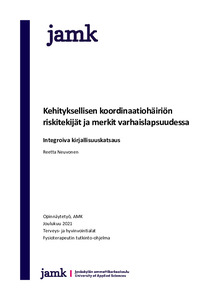Kehityksellisen koordinaatiohäiriön riskitekijät ja merkit varhaislapsuudessa : Integroiva kirjallisuuskatsaus
Neuvonen, Reetta (2021)
Neuvonen, Reetta
2021
Julkaisun pysyvä osoite on
https://urn.fi/URN:NBN:fi:amk-2021121325650
https://urn.fi/URN:NBN:fi:amk-2021121325650
Tiivistelmä
Kehityksellinen koordinaatiohäiriö eli DCD on oirekuvaltaan yksilöllinen, mutta se ilmenee erilaisina motorisen toiminnan haasteina, kuten motorisen suunnittelun vaikeutena, liikkeiden kömpelyytenä, tahattomina kaatumisina sekä välineenkäsittelyn haasteina. Liitännäishäiriöiden myötä DCD on kompleksinen kehityshäiriö, jonka haasteet näkyvät motoriikan lisäksi muilla kehityksen eri osa-alueilla. Häiriön ydin on motoriikan haasteissa, mutta sen moniulotteisuuden vuoksi lapsi voi tarvita moniammatillista tukea, joten tarvittavien tukitoimien käynnistämiseksi on varhainen tunnistaminen tärkeää. DCD-diagnoosi voidaan vahvistaa aikaisintaan viiden vuoden iässä, mutta häiriöstä voidaan nähdä merkkejä jo varhaislapsuudessa.
Opinnäytetyön tarkoituksena oli lisätä lasten kanssa työskentelevien fysioterapeuttien tietoisuutta kehityksellisestä koordinaatiohäiriöstä. Tavoitteena oli integroivan kirjallisuuskatsauksen keinoin selvittää DCD:n merkittävimpiä riskitekijöitä, sekä tietoa siitä, miten se voi näkyä jo varhaislapsuudessa 0–18 kuukauden iässä. Aineistonhaussa hyödynnettiin kolmea eri tietokantaa, ja lopulta kirjallisuuskatsaukseen
valikoitui kuusi tutkimusta, joiden pohjalta etsittiin vastauksia asetettuihin tutkimuskysymyksiin.
Kirjallisuuskatsaukseen valikoitujen tutkimusten perusteella todettiin, että keskosuus on DCD:n kannalta merkittävä riskitekijä. Muita merkittäviä riskitekijöitä oli poikasukupuoli, synnyttäjän korkea ikä, uhkaava keskenmeno, etinen istukka, istukan ennenaikainen irtoaminen, synnytyksenaikainen hapenpuute, lapsen synnytyksen jälkeinen steroidihoito ja lapsen oleminen perheen ainoa lapsi. Vanhempien koulutustaustalla ja lapsen syntymäpainon merkityksestä oli tutkimusten välillä eriäviä mielipiteitä. DCD:n varhaisia merkkejä valikoitujen tutkimusten mukaan olivat motoristen virstanpylväiden viiveinen saavuttaminen, konttausvaiheen väliin jääminen sekä lapsen yksipuoliset ja jäykät liikkeet. Vaikka asetettuihin tutkimuskysymyksiin saatiin vastauksia, jäi varhaisten merkkien osalta saatu tieto vähäiseksi ja yksipuoliseksi. The symptoms of developmental coordination disorder (DCD) are individual, but it appears in different motor challenges such as in difficulty in motor planning and object control skills, but also as clumsy and uncoordinated movements. Due to the co-occuring characteristics DCD is a complex disorder and its challenges reaches beyond the motor challenges to the other divisions of the development. The core of the disorder is in the motor challenges but owing to its multidimensionality, the child diagnosed with DCD might benefit of multidisciplinary support. The early identification of DCD is significant in order that the child would receive the support that is needed. The diagnosis of DCD cannot be confirmed before the age of five but there can be seen early signs of the disorder already in the early childhood.
The purpose of the thesis was to augment knowledge of the pediatric physiotherapists about the developmental coordination disorder. The aim of the thesis was to investigate the remarkable risk factors and the early symptoms of the DCD at the age of 0–18 months and produce an integrative literature preview. The studies that were exploited were searched from the three different databases and after the information retrieval, six studies were chosen to be used in the literature preview.
Based on the chosen studies it was discovered that the prematurity is a significant risk factor of the DCD. The other notable risk factors were male gender, advanced maternal age, threatened abortion, placenta previa, placental abruption, asphyxia during the labor, steroid treatment after the birth, and being the only child of the family. There were differing options between the studies if the parental education and low birthweight are related to DCD or not. According to the studies the early signs of DCD that can be seen were the later achievement of the motor milestones, missing the phase of crawling on hands and knees and monotonous and jerky movements of the child. Although there was found answers for the research questions, the information that was received about the early signs of the DCD was slight and one-sided.
Opinnäytetyön tarkoituksena oli lisätä lasten kanssa työskentelevien fysioterapeuttien tietoisuutta kehityksellisestä koordinaatiohäiriöstä. Tavoitteena oli integroivan kirjallisuuskatsauksen keinoin selvittää DCD:n merkittävimpiä riskitekijöitä, sekä tietoa siitä, miten se voi näkyä jo varhaislapsuudessa 0–18 kuukauden iässä. Aineistonhaussa hyödynnettiin kolmea eri tietokantaa, ja lopulta kirjallisuuskatsaukseen
valikoitui kuusi tutkimusta, joiden pohjalta etsittiin vastauksia asetettuihin tutkimuskysymyksiin.
Kirjallisuuskatsaukseen valikoitujen tutkimusten perusteella todettiin, että keskosuus on DCD:n kannalta merkittävä riskitekijä. Muita merkittäviä riskitekijöitä oli poikasukupuoli, synnyttäjän korkea ikä, uhkaava keskenmeno, etinen istukka, istukan ennenaikainen irtoaminen, synnytyksenaikainen hapenpuute, lapsen synnytyksen jälkeinen steroidihoito ja lapsen oleminen perheen ainoa lapsi. Vanhempien koulutustaustalla ja lapsen syntymäpainon merkityksestä oli tutkimusten välillä eriäviä mielipiteitä. DCD:n varhaisia merkkejä valikoitujen tutkimusten mukaan olivat motoristen virstanpylväiden viiveinen saavuttaminen, konttausvaiheen väliin jääminen sekä lapsen yksipuoliset ja jäykät liikkeet. Vaikka asetettuihin tutkimuskysymyksiin saatiin vastauksia, jäi varhaisten merkkien osalta saatu tieto vähäiseksi ja yksipuoliseksi.
The purpose of the thesis was to augment knowledge of the pediatric physiotherapists about the developmental coordination disorder. The aim of the thesis was to investigate the remarkable risk factors and the early symptoms of the DCD at the age of 0–18 months and produce an integrative literature preview. The studies that were exploited were searched from the three different databases and after the information retrieval, six studies were chosen to be used in the literature preview.
Based on the chosen studies it was discovered that the prematurity is a significant risk factor of the DCD. The other notable risk factors were male gender, advanced maternal age, threatened abortion, placenta previa, placental abruption, asphyxia during the labor, steroid treatment after the birth, and being the only child of the family. There were differing options between the studies if the parental education and low birthweight are related to DCD or not. According to the studies the early signs of DCD that can be seen were the later achievement of the motor milestones, missing the phase of crawling on hands and knees and monotonous and jerky movements of the child. Although there was found answers for the research questions, the information that was received about the early signs of the DCD was slight and one-sided.
